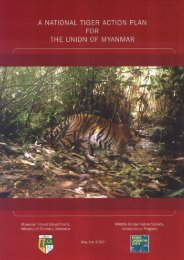Thailand Tiger Action Plan - Global Tiger Initiative
Thailand Tiger Action Plan - Global Tiger Initiative
Thailand Tiger Action Plan - Global Tiger Initiative
You also want an ePaper? Increase the reach of your titles
YUMPU automatically turns print PDFs into web optimized ePapers that Google loves.
IntroductionThe tiger, Panthera tigris, is one of the world's most magnificent animals.Classified as endangered on the IUCN Red List of Threatened species(IUCN 1996 amended by Cat Specialist Group 2001) the tiger faceswidespread extinction in the near future if poaching, habitat loss, and preydepletion continue. In the last 25 years, a significant number ofpopulations have gone extinct across the species’ range and many othersare on the verge of local extinction.<strong>Tiger</strong>s in <strong>Thailand</strong> face similar threats to those in other range states andboth the range and number of tigers have continued to decline in <strong>Thailand</strong>due to direct poaching of tigers driven by a thriving illicit commercialwildlife trade, poaching of tiger’s prey driven by local demands on wildmeat as delicacy, and land encroachment within and around protectedareas driven by a mixture of inefficient law enforcement and land use.However, tigers still occur in many protected areas in different parts of thecountry. Unfortunately tigers in most areas exist in the vulnerable stateswith populations far below a viable level. It is clear that only one landscapestands out as the stronghold of the largest tiger populations in <strong>Thailand</strong>and, perhaps, Southeast Asia. The landscape is very well acknowledgedas the Western Forest Complex along the Tenasserim mountain rangealong the border with Myanmar. The highest density of tigers are at thecore of WEFCOM within the Huai Kha Khaeng and Thung Yai NaresuanWildlife Sanctuaries (HKK-TY), a Natural World Heritage site.Since the last <strong>Tiger</strong> <strong>Action</strong> <strong>Plan</strong> published in 2004, important interventionsand monitoring with the tiger focus have happened in the WEFCOM andsome other protected areas along the Tenasserim. The government of<strong>Thailand</strong> under the leadership of the Department of National Parks,Wildlife, and <strong>Plan</strong>t Conservation, together with other local and internationalpartners, has modernized the patrol and monitoring systems in wildlifesanctuaries and national parks within Tenasserim – WEFCOMlandscapes. Such systems have been incorporated into this action plan inthe hope of scaling up the systems to safeguard and recover wild tigers inexisting and potential tiger landscapes in <strong>Thailand</strong>.This plan represents a substantial revision of <strong>Thailand</strong>’s first <strong>Tiger</strong> <strong>Action</strong><strong>Plan</strong> published in 2004 (Tunhikorn et al. 2004). Key additions and changesinclude:• Several new goals and actions that make up the heart of the plan• An explicit specification of a 12 year time horizon for the plan• Formulation of the plan as a mechanism to provide strategicguidance for tiger conservation in <strong>Thailand</strong> (rather than detailedoperational prescriptions)• A revised “Status of <strong>Tiger</strong>s in <strong>Thailand</strong>” that reflects recent work todetermine the occurrence, relative abundance, and absoluteabundance of tigers at the national and site levels
















